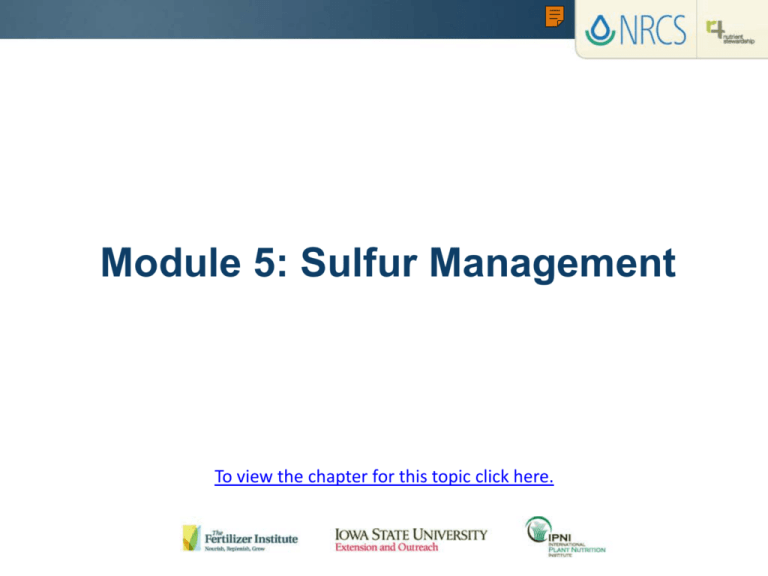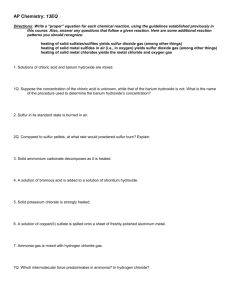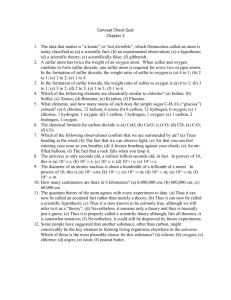Module 5: Sulfur Management
advertisement

Module 5: Sulfur Management To view the chapter for this topic click here. Module 5: Sulfur Management Introduction • Sulfur (S) is often classified as a “secondary” plant essential element. • Importance of S: o constituent of three essential amino acids o necessary in the formation of chlorophyll, vitamins, enzymes, and aromatic oils o essential for high protein content in forages o plays an important role in crop quality such as wheat grain for making bread o needed for N fixation by legumes Module 5: Sulfur Management Introduction • • Sulfur deficiencies are on the rise due to: o the shift to more concentrated fertilizers, containing little to no S o reduction of sulfur dioxide (SO2) emissions o higher S removal by more productive crops Sulfur deficiency symptoms: o yellowing and interveinal chlorosis (similar to N deficiency) o often more evident in younger leaves (opposite to N) o generalized in the entire plant if deficiency is severe Module 5: Sulfur Management Example of Sulfur deposition with rainfall in the U.S. Module 5: Sulfur Management Sulfur Amount in Harvested Portions of Crops Pounds of S per unit of yield Corn bu 0.07 Corn silage ton 0.58 Soybean bu 0.10 Oat and Straw ton 4.50 Wheat bu 0.08 Barley bu 0.08 Alfalfa ton 5.00 Clover ton 3.00 Adapted from Modern Corn and Soybean Production. 2000. MCPS Publications. Crop Unit of Yield Module 5: Sulfur Management Testing for Sulfur Sufficiency • Sampling soil, plant tissue, and irrigation water are methods for determining S supply and needs. • Soil testing for inorganic S (SO4-2-S) is not as reliable as for other nutrients. • An alternative is use of an index that incorporates several factors besides a S test only. • A low testing soil may still supply a crop with adequate S because of: o ample plant available S below the testing depth o significant organic S mineralized during the growing season o high S levels in shallow groundwater Module 5: Sulfur Management Testing for Sulfur Sufficiency – 0 to 6 inch soil test for extractable soil sulfate-sulfur Corn grain yield response to S application as related to extractable soil sulfate-S concentration (0-6 inch soil depth) in the no-S control. Data from a multi-year study conducted in Iowa. Module 5: Sulfur Management Testing for Sulfur Sufficiency – Plant tissue testing for Sulfur Yield increase per cut from S fertilization relative to the alfalfa plant tissue S concentration (6-inch plant top) with no S applied. Data from a multi-year study conducted in Iowa. Module 5: Sulfur Management Testing for Sulfur Sufficiency – Plant tissue testing for N:S ratio Relationship between relative yield of wheat and plant tissue N:S ratio. Adapted from K. Spencer and J.R. Freney (1980). Agron. J. 72:469-472. Module 5: Sulfur Management Basis for Sulfur Fertilizer Recommendations • Yield responses to S occur most commonly: o in crops with higher S requirements such as alfalfa, canola, and corn o when most of the plant material is removed o in sandy or eroded soils o soils low in organic matter o soils with low sulfate-S content in the profile • Unlike N-P-K, S deficiency determination and associated fertilization guidelines do not exist in many regions of the U. S. • The existing S fertilization recommendations often are based on: o plant testing (for specific crops when reliable) o local yield response trials o soil properties/conditions associated with response to S Module 5: Sulfur Management Examples of Sulfur Rate Determination • University of Wisconsin o S availability index (SAI) = (soil test SO4-2-S x 4) + Subsoil-S + precipitation-S + (% OM x 2.8 lb/acre) + available manure-S. If SAI > 40 If SAI > 30 If SAI >30 and <40 • application of 10-50 lb S/acre tissue test recommended Alabama o • adequate All crops receive 10 lb S/acre per year. Cotton receives 20 lb S/acre. Great Plains o For canola, if soils have < 5 ppm SO4-2-S o For wheat, barley, and oats, if soils have < 3 ppm SO4-2-S 15 lb S/ac. 10 -15 lb S/acre. Module 5: Sulfur Management Example Crop Response to Sulfur Application Rate Corn grain yield response to S application rate at responsive sites. Data from a multi-year study conducted in Iowa. Module 5: Sulfur Management Example Crop Response to Sulfur Application Rate Cotton lint yields as affected by the rate of S on a Lucy loamy sand. Data from a multi-year study conducted in Alabama. Module 5: Sulfur Management Sulfur Sources Fertilizer Source Formula Analysis (N-P-K-S) Ammonium sulfate (NH4)2SO4 21-0-0-24 Ammonium thiosulfate (ATS) (NH4)2S2O3 12-0-0-26 Gypsum CaSO4 • 2H2O 0-0-0.5-17 Epsom salt MgSO4• 7H2O 0-0-0-14 Granular elemental S S + bentonite 0-0-0-90 K4SO4• 2MgSO4 0-0-22-23 K4SO4 0-0-50-18 Potassium magnesium sulfate Potassium sulfate Module 5: Sulfur Management Sulfur Timing and Placement • Desired goal: time S fertilizer applications so S is available when the crop needs it. • Application of a sulfate form well in advance of crop uptake can be subject to leaching losses in soils with high leaching potential. o In those soils, application close to or at planting would be desirable. Sidedress applications can be beneficial. • Sulfate leaching is slow in most soils due to interaction with soil clays. • Application of elemental S should be in advance of crop need so there can be conversion to sulfate. • For forages, there are more opportunities for application due to multiple cuttings. • Applied S must be in the rooting zone for plant uptake: banding or incorporation into the soil is desirable. • Surface application must be well in advance of crop need and in or converted to the sulfate form so movement into the soil can take place with rainfall. Module 5: Sulfur Management Summary • Sulfur management requires a thorough understanding of how different factors can affect the plant availability of S and potential deficiency: o temperature and moisture o soil organic matter and texture o erosion o tillage system o landscape position o rooting depth o subsoil sulfate o past S inputs o atmospheric deposition o cropping system • The frequency of S deficiencies is increasing and so is the need for supplemental S. • Therefore, S needs to be considered for developing successful nutrient management plans.





